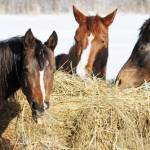Understanding Dry Matter in Forage for Horses

Horse owners may have heard suggestions as to how much hay to give their horses, typically around 1.5 to 2% of the horse’s weight in hay each day. This amount of hay is designated as a “dry matter” weight. What is meant by “dry matter,” and what is the importance of this designation?
Dry matter refers to how much of the forage is left after any moisture has been removed. Baled hay seems fairly dry, but it does contain some moisture. However, the concept of dry matter is mostly theoretical in this case, as most barns have no way to measure moisture content of hay easily or accurately.
To a nutritionist, dry matter is important as a way to compare the nutritive values of different forages. Hay is typically 85 to 95% dry matter, but pastures contain much more water and can contain as little as 15 to 20% dry matter. This water dilutes the other components of the forage, so for an apple-to-apples comparison, the composition of forages should be compared on a 100% dry matter basis.
For example, hay that is 90% dry matter may be 14.4% protein on an as-fed basis. This is equivalent to 16% protein on a 100% dry matter basis. The difference between as-fed and dry matter for this hay is not great. Compare this to a pasture sample that is 25% dry matter. If it contained 4% protein on an as-fed basis, this would equal 16% protein on a 100% dry matter basis. The hay and pasture actually have identical protein contents when the water is removed.








